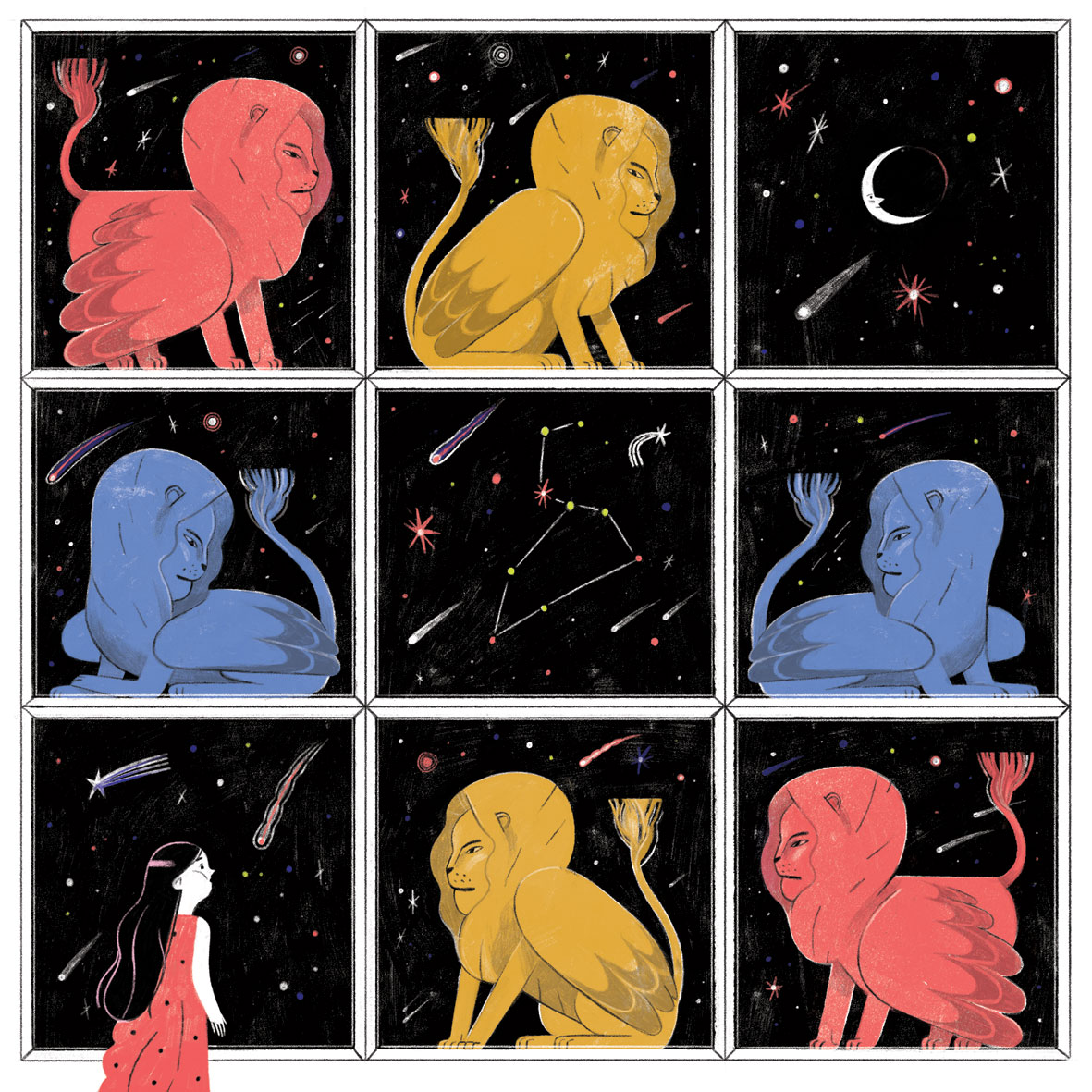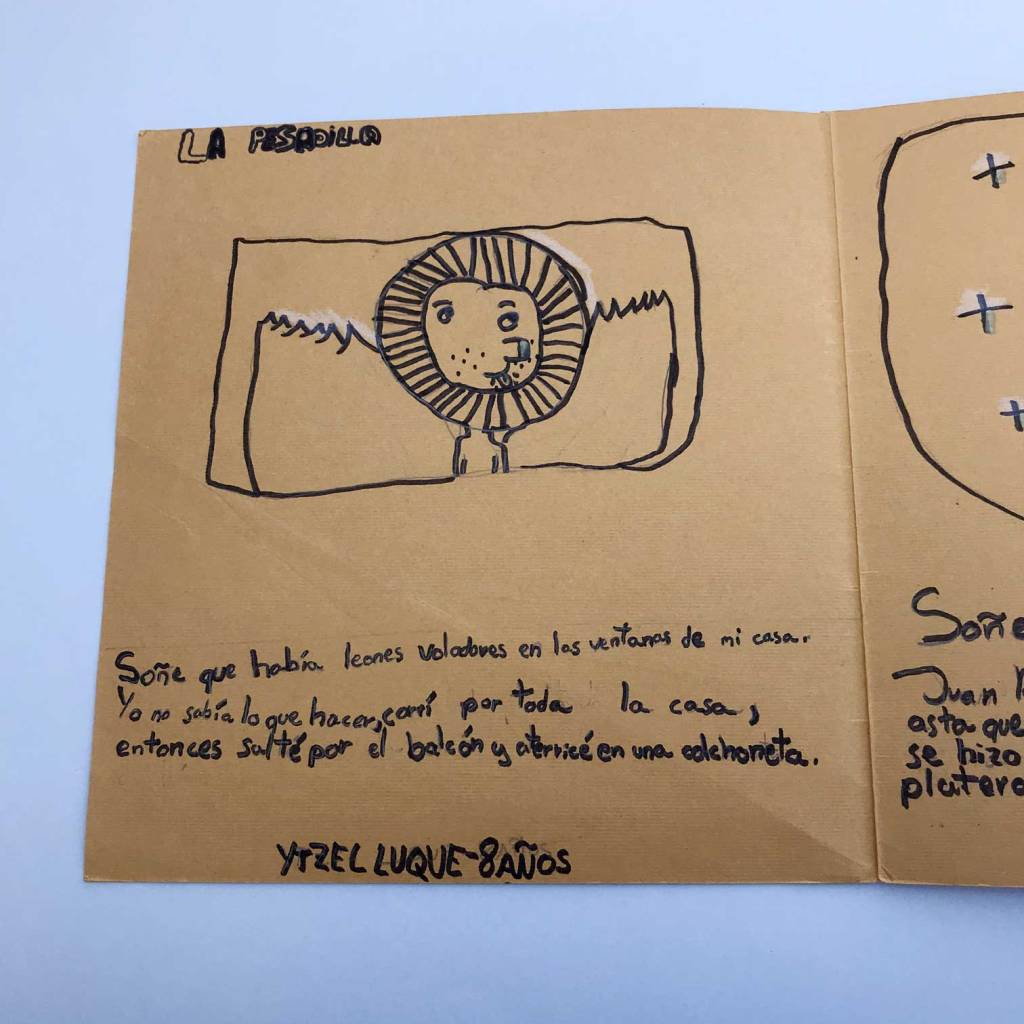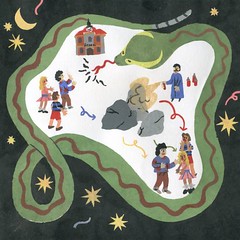Anja Sušanj
agosto 4, 2020

Sanjala sam da su na prozorima moje kuće leteći lavovi. Nisam znala što da radim. Protrčala sam kroz kuću, skočila s balkona i sletjela na madrac. (Itzel, 8 god/ Španjolska)
Undulating interview with Anja Sušanj
13/July/2020
-Hi Anja! Why did you choose to illustrate Itzel´s dream? There was just something about the flying lions that sounded whimsical to me and I wanted to depict them. I also immediately “saw” a star-crossed sky, which I love to draw, so it was a no-brainer, really.
-You created a wonderful image that is like a dream itself. Can you describe your first ideas and how they developed into the final version? I made a lot of sketches, and my first ideas consisted of a more straightforward approach – having a little girl in front of giant windows on which there were lions, with drapery, armchairs, other elements typical of a living room/bedroom. As it’s a dream, I wanted to play with the composition and really break away from the first visual association I got – which was the frontal scene described above. She never mentions how many lions, we only know it’s more than one, so in the end I decided on an ornamental approach.
-In your illustration the lion appears in various forms. We see the constellation of Leo in the middle of some sphinxs-like lions. Is this approach to the dream inspired by the mythology of the “winged lion”? Actually, I was mostly motivated by the composition – meaning, I wanted the finished piece to function both through storytelling (by depicting Itzel’s narrative) and as a design piece, that is almost pattern-like and has a reduced colouring and is very symmetrical in many ways. I wanted the lions to feel otherworldly, so I made them stiff and in mirroring positions, almost like living statues, that feel both real and unreal at the same time. I realise the blue ones are sitting like the sphinx, but the reference is only visual, as their stiffness was crucial for me. Also, I wanted the whole scene to feel odd and somewhat uncomfortable, but not necessarily something that will strike fear.
-How would Anja kid have reacted to the flying lions? This is a tough one – I think she would have loved the idea of flying lions, she’d have assumed they all talked as well and would have chatted away. She’d also probably try to make them fly her somewhere, she wanted to see everything up close. She’d think of them as a bit mischievous, but wouldn’t be afraid. As an adult woman, I’d probably be much more cautious.
-Do your dreams influence you in any way? Have you ever recovered dream characters or events to portray in your illustration work? Oh, yes, actually – especially when I was younger – I used to come up with stories that were often based on dream sequences. My dreams are quite vivid, when I do remember them, so oftentimes whole worlds and characters would emerge from them. I wouldn’t say my dreams influence me, but as I’m quite the analytical person, when I do remember them I tend to really dive into them to draw out as much creative juice as I can. I don’t believe dreams are more than a sum of our experiences and general thoughts, but they do end up being quite a good source for whimsical storytelling.
-If we could enter into one of your actual nightmares, what would we see? Probably a lot of insects, as I’m a bit entomophobic.
-Is there any childhood dream or nightmare that you remember until now? I remember some, but there’s one that really stuck with me, as it was recurring.
It’s mostly just an instant, not a whole narrative, of a woman with a cat’s head and tail, wearing some unknown formal wear and with huge wings resting peacefully on her back. She’s standing on a moving bridge, made of rope and wood, hanging over an abyss. The sky is tinted green pink, but the abyss is dark purple and it feels like a moving, dense fog. Still, she isn’t looking at it, she is staring right in front of her, at a point we cannot see, as we’re facing her instead. We cannot turn and don’t know what’s behind us. She seems tense, although her face is expressionless. After a few long, strained moments, she just jumps and takes flight. We don’t know where she went and are only left with the moving bridge, that’s slowly undulating back into immobility.
Funnily enough, only when I was half-way through writing this I realised she is a flying cat and that I chose to write about a dream that has a similar figure to Itzel’s!
-Do you know any Croatian tradition or popular belief about dreaming? There are some, this one the most coherent of all: Mora is the croatian word for nightmare (cro. noćna mora – night mare) and it references a creature that enters one’s bedroom through a keyhole, disguised as a moth, and sits on the chest of the person asleep (sometimes in cat form, sometimes as a beautiful woman), which makes it difficult to breathe. It is believed she would drain the energy of the person asleep, leaving them weak and breathless. This belief is found not only in slavic, but other mythologies, with somewhat different details, but where I come from she tends to take the form of a cat. She is also sometimes connected to Morana, a slavic deity.
-Please tell a recent dream of your own. Recently, I’ve been dreaming of a house.
It’s not your average two-storey family home, mind you, but a huge, possibly endless, conglomerate of merged hallways, walls and towers. It’s mostly made of white wood, a bit gothic in nature, with bridges and stairs, and endless rooms – it feels impossible to map.
Like a paper collage animated in real time, it’s a fixed place that somehow keeps changing shape and form all the same; a place that sometimes houses endless meadows, and is simultaneously just a square empty room. The walls are thick, but sometimes they aren’t, sometimes they are glass, and sometimes there are none at all. At times, the staircases lead somewhere, but most times they go nowhere. Every so often there is a whole city there, crowded, with roads, and people, and laughters, and lives, only for it to become an empty space, quiet and bright and too big for just one person.
It’s a house that’s in constant flux, impossible to map, the very epitome of change, as it’s always the same, and yet always different. There is no mold that could fit it.
I know it very well, its halls feel ancient and familiar to me. Yet, when I walk through them I never know what I’ll find going through a door. I meet people there I do not know, and find places I have long forgotten existed.
This house stands tall within nothing and everything, it has a waterfall up in one tower that never reaches the bottom. I’m not even sure there is an end to it for the water to reach. It only sort of disperses itself in thin air, midway.
I’ve recently been dreaming a lot about this house, its halls feel new and exciting to me, yet when I walk through them, I know every bit, every detail, every shape.
I know this house very well, and not at all.
Huge thanks Anja! No problem Roger, thank you!
-¡Hola Anja! ¿Qué te motivó a ilustrar el sueño de Itzel? Los leones voladores tienen algo enigmático que me apetecía explorar. También vi de inmediato un cielo estrellado, cosa que me encanta dibujar. No dudé.

-Sin ceñirte estrictamente al texto original, creaste una ilustración que por sí misma es un sueño. ¿Cuáles fueron tus primeras ideas y cómo progresaron hacia la imagen final? Hice muchos sketches y mis primeras ideas eran algo más literal, con la pequeña soñadora frente a unas ventanas gigantes donde había leones… y cortinas, sillones y demás mobiliario típico de una habitación. Al tratarse de un sueño, preferí jugar con la composición y alejarme de las primeras asociaciones visuales y de la escena frontal que antes describí. La niña no mencionó cuántos leones había. Sabemos que hay más de uno, así que al final decidí hacer algo ornamental.
-El personaje del león adopta en tu dibujo varias formas: en la parte central vemos la constelación de Leo, escoltada por leones alados en posturas de esfinges. ¿Asocias tu interpretación del sueño de Itzel con la mitología? No tanto. Me motivaba más trabajar en la composición. Quería que la pieza tuviera una doble función: narrativa (que contara el sueño de Itzel) y ornamental (casi como un patrón, simétrico en muchos sentidos y de color limitado). Quería dar a los leones una apariencia sobrenatural, así que los dibujé rígidos y en posiciones de espejo, casi como estatuas vivientes, reales e irreales a la vez. Es cierto que los leones azules están sentados como esfinges, pero dicha referencia es sólo visual, para mostrar una rigidez que consideré crucial. También quería que toda la escena se sintiera extraña y algo incómoda, pero no espantosa.
-¿Cómo habría reaccionado la Anja niña ante los leones voladores? Es una pregunta difícil. Creo que le habría encantado la idea, habría asumido que hablaban y se hubiera puesto a platicar con ellos. Probablemente habría tratado de que la llevaran volando para ver el cielo de cerca. Los leones le habrían parecido algo traviesos, pero sin asustarla. Ahora, como mujer adulta, sería más cauta.
-¿Te influyen tus sueños de alguna manera? ¿Los has dibujado alguna vez? Sí, especialmente cuando era más joven acostumbraba crear historias a menudo basadas en secuencias soñadas. Mis sueños son intensos. Al recordarlos brotan personajes y mundos nuevos. No diría que me influyen porque soy muy analítica, pero me sumerjo en ellos y les saco tanto jugo creativo como pueda. No creo que los sueños sean más que una suma de experiencias y pensamientos globales, pero resultan un excelente recurso para contar historias fantásticas.
-Si entráramos en una de tus pesadillas, ¿qué veríamos? Probablemente muchos insectos, porque soy algo entomofóbica.
-¿Hay algún sueño o pesadilla infantil que recuerdes hasta la fecha? Recuerdo algunos sueños, pero hubo uno recurrente que se ha quedado conmigo. Es apenas un instante, no una trama completa, sobre una mujer con cabeza y cola de gato, con una indumentaria desconocida y formal y unas alas enormes descansando plácidamente en su espalda. Está de pie en un puente hecho de madera y cuerdas, colgando sobre el abismo. El cielo está teñido de rosa verdoso pero el abismo es de un morado intenso. Flota una niebla densa. La mujer gato tiene la mirada fija al frente, en un punto que nosotros no vemos porque está detrás nuestro y no podemos girarnos. Parece tensa, aunque su cara es inexpresiva. Después de varios instantes largos y tensos, salta y emprende el vuelo. No sabemos a dónde fue y nos quedamos a solas frente al puente, que se mece suavemente hasta quedarse inmóvil.
¡Mira qué curioso! Cuando había escrito la mitad de la respuesta, me di cuenta que soñé con una gata voladora, un personaje parecido al león volador del sueño de Itzel.
-¿Conoces en Croacia alguna creencia popular relacionada con el mundo de los sueños? Algunas. Hablaré de la más coherente. “Mora” es la palabra croata para “pesadilla” (cro. noćna mora – night mare), y hace referencia a una criatura que, disfrazada de polilla, entra al dormitorio por la cerradura y se sienta sobre tu pecho mientras duermes (a veces adopta la forma de un gato, otras veces es una hermosa mujer), dificultando tu respiración. Se cree que drena tu energía hasta dejarte debilitado y sin aliento. Ésta no es sólo una creencia eslava. Aparece en otras mitologías pero varían los detalles. De donde vengo suele tomar la forma de un gato. En ocasiones también se le asocia con “Morana”, la deidad eslava.
-Cuéntame un sueño reciente. Últimamente he estado soñando con una casa. No es la tradicional casa familiar de dos plantas sino un enorme, quizá infinito, conglomerado de pasillos, paredes y torres interconectadas. Construida casi en su totalidad con madera blanca, un poco estilo gótico, con escaleras y cuartos interminables – resulta imposible trazarla en un mapa.
Como un collage de papel que se anima en tiempo real, es un lugar que está cambiando constantemente de forma; un lugar que por momentos alberga interminables praderas y que al mismo tiempo es sólo una habitación cuadrada y vacía. Las paredes fluctúan entre el grosor y la delgadez, unas veces son de cristal y otras no existen. En algún momento las escaleras conducen hacia algún lugar pero la mayor parte del tiempo no van hacia ninguna parte. De vez en cuando hay una gran ciudad abarrotada, con caminos, gente, risas y vidas… que se transforman en un espacio vacío, silencioso, brillante y muy grande para una sola persona.
Es una casa que fluctúa constantemente, imposible de mapear, la epítome perfecta del cambio, siempre igual y siempre distinta. No hay un molde que pueda contenerla.
La conozco muy bien. Reconozco sus antiguos salones. Sin embargo, cuando los recorro, nuncá sé qué habrá detrás de cada puerta. Me encuentro con personas desconocidas, con lugares que hace mucho tiempo olvidé que existían.
Esta casa se mantiene erguida dentro de todo y nada. Por una de las torres cae una cascada que nunca llega al suelo. No estoy segura si hay algún fondo que alcanzar porque, a medio camino, la cascada se dispersa en el aire.
Recientemente he soñado mucho con esta casa. Sus salones me parecen novedosos y emocionantes, pero caminando en ellos reconozco cada rincón, cada detalle, cada forma.
Conozco muy bien esta casa y la desconozco absolutamente.
-¡Muchas gracias, Anja! A ti, Roger.

